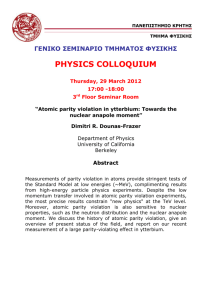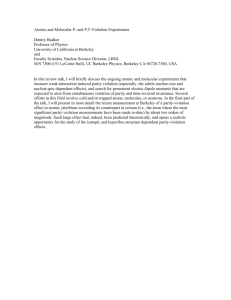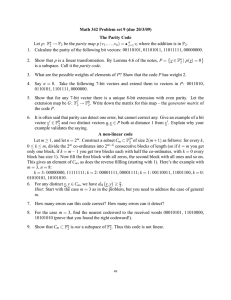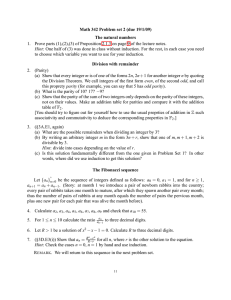High Energy Physics Lecture 11 A) Neutrino Deep Inelastic Scattering
advertisement
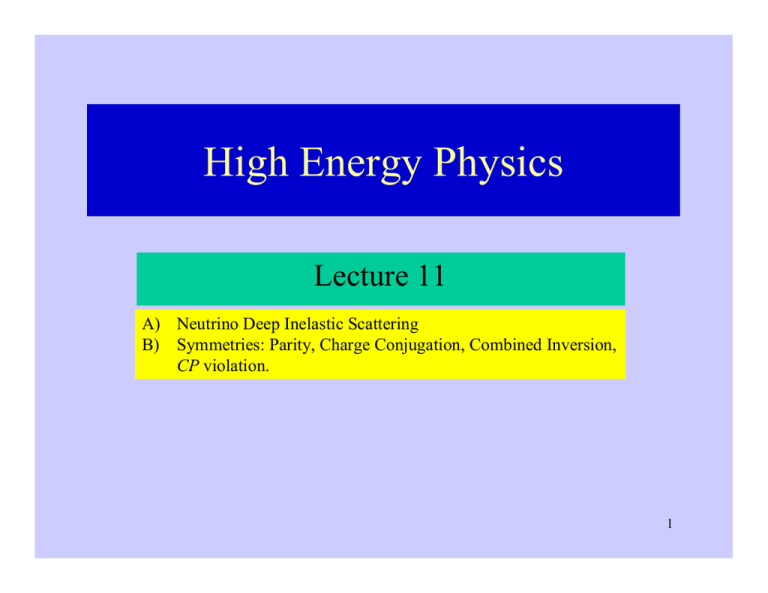
High Energy Physics
Lecture 11
A) Neutrino Deep Inelastic Scattering
B) Symmetries: Parity, Charge Conjugation, Combined Inversion,
CP violation.
1
Neutrino Deep Inelastic Scattering
Feynman diagram of neutrino-proton DIS
the process shown has a charged outgoing
lepton: this is a Charged Current reaction
in which a charged IVB W is exchanged.
The differential cross section is given by
⎛
d 2σ CC 4πα 2 CC ⎪⎧⎛
x 2 y 2 M 2 ⎞ CC
y 2 ⎞ CC ⎫⎪
2 CC
=
η ⎨⎜1 − y −
⎟ F2 + xy F1 ± ⎜ y − ⎟ xF3 ⎬
2
2
2 ⎠
dxdy
xyQ
Q
⎠
⎝
⎩⎪⎝
⎭⎪
2
⎞
1 ⎛ GF M W2
Q2
CC
⋅ 2
± : + ( − ) for incoming ν (ν
η = ⎜
⎟ ;
2 ⎝ 4πα Q + M W2 ⎠
Callan-Gross Relation : F2CC = 2 xF1CC
)
A deviation from the C-G relation is denoted by FL = F2 − 2 xF1
2
Hard sub-process of neutrino-proton DIS:
the dominant sub-process in antineutrino-proton
DIS is the collision of the antineutrino with an
up-type quark which turns into a down-type quark;
(the down-type antiquark sea is also probed).
the dominant sub-process in neutrino-proton
DIS is the collision of the neutrino with a
down-type quark which turns into a up-type quark;
(the up-type antiquark sea is also probed).
Within the quark-parton model the corresponding structure functions are:
(
) (
F (ν p → e X ) = F ( e
)
p → ν X ) = 2 ( u − d − s + c + ...)
F2 ν p → e + X = F2 e − p → ν X = 2 x ( u + d + s + c + ...)
+
3
3
(
) (
F (ν p → e X ) = F ( e
−
)
p → ν X ) = 2 ( d − u + s − c + ...)
F2 ν p → e − X = F2 e + p → ν X = 2 x ( u + d + s + c + ...)
−
3
3
+
To get the structure functions of neutrino-neutron DIS exchange u with d.
3
Thus F2 is the total quark+antiquark distribution, and F3 is the valence quark
distribution.
The sum and difference of the neutrino and antineutrino differential cross sections,
integrated over x, have a very simple y dependence:
dσ (ν )
dy
dσ (ν )
dy
+
−
dσ (ν
dy
dσ (ν
dy
) ∝ ⎡1 +
⎣
) ∝ ⎡1 −
⎣
1
(1 − y ) ⎤⎦ ∫ x ⎡⎣ q ( x ) + q ( x )⎤⎦ dx
2
0
1
(1 − y ) ⎦⎤ ∫ x ⎡⎣ q ( x ) − q ( x )⎤⎦ dx
2
0
where q ( x ) = u ( x ) + d ( x ) + s ( x ) + ... and q ( x ) = u ( x ) + d ( x ) + s ( x ) + ...
Experimental data (from the CDHS experiment) are in agreement with this
result: see figure on the next page.
A corollary of this agreement is that FL, i.e. the deviation from the Callan-Gross
relation, is small.
4
Conclusions: good agreement of theory with experiment means that the
process is well understood; it also implies that FL is small.
5
Comparison of CC with NC DIS:
The SFs F2 of CC and NC DIS are proportional to the total quark+antiquark
distribution. Their ratio is therefore constant:
F2NC ( x )
2
2
1 ⎡⎛ 2 ⎞ ⎛ 1 ⎞ ⎤ 5
= ⎢⎜ ⎟ + ⎜ − ⎟ ⎥ =
CC
F2 ( x ) 2 ⎢⎣⎝ 3 ⎠ ⎝ 3 ⎠ ⎥⎦ 18
The structure functions F2 of
CC and NC processes (appropriately
scaled) are seen to coincide.
6
An interesting process initiated by incident neutrinos is opposite-charge muon
pair creation:
ν + N → μμν X
In the Feynman diagram the particle symbols
are understood in a generic sense:
if the incident particle is a neutrino (antineutrino),
then the outgoing particle is a muon (antimuon)
and the exchanged IVB is a W+ (W-), the
incoming quark is a d or s (anti-d or anti-s), etc.
The main interest of this reaction lies in the following: the cross sections of the
hard sub-processes with an incoming d quark are strongly suppressed:
σ (ν d → μ − c ) ∝ xd ( x ) sin 2 θC ; σ (ν d → μ + c ) ∝ xd ( x ) sin 2 θ C
σ (ν s → μ − c ) ∝ xs ( x ) cos 2 θC ; σ (ν s → μ + c ) ∝ xs ( x ) cos 2 θC
where θC is the Cabibbo angle: sinθC≈0.22, i.e. sin2θC≈0.05; thus in this
reaction one probes the strange quark sea!
7
Experimentally the like-sign muon pair events have a characteristic signature:
(i) opposite-sign muon pairs are seen, like-sign ones are not;
(ii) usually one of the muons has a low energy;
(iii) the low-energy muon is correlated to hadron jet of which the c quark is a part.
Most recently opposite-sign dimuon events have been studied by the CHARM-II
collaboration. Shown here is a schematic view of the CHARM-II detector:
8
Example of a like-sign dimuon event seen in the CHARM-II detector: note
the much stronger curvature of one of the muon tracks in the magnetic field
of the muon chamber, characteristic of a lower momentum.
Ref.: CERN-EP-98-128 (August 1998)
9
The result of the CHARM-II study of dimuon events is expressed by the strange
sea quark content of the nucleon with respect to the non-strange quark sea:
1
κ=
∫ dx { xs ( x ) + xs ( x )}
0
1
∫ dx { xu ( x ) + xd ( x )}
= 0.39 ± 0.09
0
Within the experimental errors this result is in agreement with results from
experiments CDHS and CCFR:
Experiment
events
κ
CDHS
8600
0.48±0.08
CCFR
4200
0.37±0.05
CHARM-II
3100
0.39±0.09
10
Summary of discussion of neutrino DIS
Neutrino DIS is complementary to charged lepton DIS in that it probes the nucleon
with the W boson rather than with the photon (or Z boson).
The combined results from CC and NC DIS, together with additional data from
hadron-hadron collisions, make it possible to extract results on the parton content
of different flavours in the nucleon.
In particular, from neutrino DIS alone one can determine the strange quark content
of the nucleon with respect to the non-strange sea quark content.
11
Symmetries: Parity, Charge conjugation, CP violation
• Conservation laws play a special role in Physics: in collisions and
in decays we find that the charge of a system of particles is
conserved, also its energy, momentum and angular momentum.
• Conservation laws are closely related to symmetries:
conservation of energy to a symmetry in time, conservation of
angular momentum to a spherical symmetry.
• In most known processes there is also a mirror symmetry. The
corresponding conservation law is called parity conservation.
Here I shall discuss the violation of parity conservation in the
weak interactions.
12
Electromagnetic processes are described by fields: an electric field E
and a magnetic field B. They are different at different points in space.
Mathematically we say that they are functions of the spatial coordinates
x, y and z and of time:
G G
G G
E = E ( x, y, z , t ); B = B ( x, y, z , t )
The equations of electromagnetism are not changed if we replace
everywhere (x,y,z) by (-x,-y,-z). This is equivalent to a mirror symmetry.
The corresponding conservation law is called parity conservation.
Particles are also described by fields. This is the essence of
quantum theory which is based on the recognition that all particles have
wave properties (particle-wave duality).
The theories describing particles and their processes are field theories.
Thus for an electron we write a wave function:
ψ = ψ ( x, y , z , t )
13
The coordinates do not denote the position of the electron.
The meaning of the wave function is that
ψ ( x, y, z , t ) dV
2
is the probability to find the electron at time t in the volume element dV
at the point (x,y,z).
Another name for the wave function of the electron is: electron field,
and one says that the electron is a quantum of the electron field.
Similarly a photon is a quantum of the electromagnetic field, etc.
If there are several electrons, then the wave function depends on the
coordinates of all particles:
The wave function contains all information about the state of the particle
or system of particles at time t. That means that it must be possible to
predict the state of the system at a later time, t+dt. This is expressed by
T Schrödinger equation:
the
∂ψ
i=
= Hˆ ψ
∂t
14
is Planck’s constant h divided by 2π and Ĥ is an
where =
operator whose mathematical form cannot be found from any more
fundamental theory: it must be guessed and then tested by experiment.
For a single electron in the Coulomb field of an infinitely heavy nucleus
the Schrödinger equation is in the nonrelativistic case of the form
= 2 ⎛ ∂ 2ψ ∂ 2ψ ∂ 2ψ ⎞ Ze 2
∂ψ
i=
ψ
=−
⎜ 2 + 2 + 2 ⎟−
2m ⎝ ∂x
∂t
∂y
∂z ⎠ r
(m is the electron mass, e is the elementary charge, Ze is the charge
of the nucleus which is assumed to be infinitely heavy and located at
the origin).
Thus the
Ĥ
operator (Hamiltonian) is in this case
2
2
2
2
2
⎛
⎞
=
∂
∂
∂
Ze
Hˆ = −
⎜ 2 + 2 + 2 ⎟−
2m ⎝ ∂x ∂y ∂z ⎠ r
15
Note that this Hamiltonian does not change (“is invariant”) if we change
the signs of all coordinates:
⎛
∂
∂
∂ ⎞ ˆ⎛
∂ ∂ ∂ ⎞
ˆ
H ⎜ − x, − y , − z , − , − , − ⎟ = H ⎜ x, y , z , , , ⎟
∂x ∂y ∂z ⎠
∂x ∂y ∂z ⎠
⎝
⎝
The transformation
( x, y , z ) → ( − x, − y , − z )
is called space inversion.
Thus our theory is invariant under space inversion if the wave function
has a symmetry:
ψ ( − x, − y, − z, t ) = ±ψ ( x, y, z , t )
i.e. the wave functions are either symmetric (positive parity) or
antisymmetric (negative parity) but do not have mixed parity.
What has been said here for the particular case of the nonrelativistic
electron in the Coulomb potential is known to be generally true for
the electromagnetic and strong interactions:
Parity is conserved in electromagnetic and strong interactions.
16
For many years it was believed that parity is also conserved in the weak
interactions.
Historical note:
the first theory of weak interactions was formulated in 1934 by Enrico Fermi
specifically for nuclear beta decays. This theory was modelled after the
theory of electromagnetic interactions. It was a parity conserving theory.
For a long time the only known weak
interaction processes were beta
decays of atomic nuclei.
There were no experimental tests
of parity conservation in weak
interactions until 1956
E. Fermi, Nobel Prize
in Physics 1938.
17
Soon after the discovery of the first few elementary particles it was
understood that many of their decays were also weak interaction
processes. In particular, pion and muon decays are weak processes:
π + → μ +ν μ ; μ + → e+ν eν μ
In order to maintain parity conservation it was necessary to ascribe to
each particle its parity as an intrinsic property like mass and charge.
The parity of a particle can be either positive (+1) or negative (-1).
But intrinsic parity is a relative property: one assigns a positive parity
to one particle, for instance to the proton, and then one finds the parities
of other particles by analysing processes between these and protons
(this is no different from charge!).
Thus it was found that for instance the pion has negative parity relative
to the proton, which is conventionally given a positive parity.
18
The relation between the parities of particles and antiparticles is different
for spin ½ particles (fermions) and spin 0 or spin 1 particles (bosons):
An antifermion has the opposite parity of the fermion
An antiboson has the same parity as the boson.
Therefore the antiproton has negative parity since we arbitrarily give
the proton a positive parity. (Proton and antiproton are spin ½ fermions.)
-
Since it was found that the π had negative parity, therefore the
π+ also had to have negative parity. (Pions are spin 0 bosons.)
Parity is multiplicative: the parity of a system of two particles is the
product of their parities and of the parity of their relative motion.
Then it follows rigorously that a two-pion system has positive
parity and a three-pion system has negative parity, provided their
relative angular momentum is zero.
19
Then, if we discover a particle that decays into a pair of pions, then we
know that it has positive parity, and if it decays into three pions, then it
has negative parity.
By 1956 there arose a difficulty, the “tau-theta paradox”: there were two
particles that looked much the same but one of them decayed by weak
interaction into two pions and the other into three pions:
τ → π + π + π − ; θ → π +π 0
(this tau not to be confused with today’s tau lepton!).
At first the experimental data were not very accurate, so the tau and theta
could be different. But with improved techniques they looked more and more
similar, so it became hard to maintain that they were different particles.
In particular, from their production in strong interaction processes one had
to conclude that they both had negative parity.
20
T.D. Lee and C.N. Yang proposed that they were the same particle, and
therefore parity had to be violated in weak interactions.
Today this particle is called K+.
Parity violation in weak interactions was soon demonstrated in
several experiments: in nuclear beta decay and in muon decay.
Today parity violation is understood to be a general property of
the weak interactions.
For their discovery of parity violation,
T.D. Lee (left) and C.N. Yang (right)
received the Nobel Prize for Physics in
1957
21
Actually, it is not quite correct to say that Lee and Yang did
discover the violation of parity. What they did was to show that
there had been no experiments to test the hypothesis of parity
conservation in the weak interactions, and they suggested ways
of setting up experiments to carry out such tests.
The citation of their Nobel prize award makes this point quite
specifically:
“for their penetrating investigation of the so-called parity laws
which has led to important discoveries regarding the elementary
particles”
22
Parity violation in processes involving neutrinos can be understood in
the following way.
The neutrino is a zero-mass spin ½ particle. Therefore its spin must be
pointing on general grounds either along its direction of motion or in the
opposite direction, but never at an angle to its direction of motion.
In the former case it is said to be right-handed, and in the latter case
it is left-handed.
There are therefore three possibilities:
(i) All neutrinos are right-handed,
(ii) All neutrinos are left-handed;
(iii) Neutrinos can be left-handed and right-handed.
There is no theory that can tell which of these is realised in nature.
The empirical evidence is that all neutrinos are left-handed and
all antineutrinos are right-handed.
23
Now if we look at the mirror image of a neutrino, then that is still a neutrino.
But a left-handed screw (or a left-handed helix) seen in a mirror is a righthanded screw, and a left-handed neutrino seen in a mirror is a right-handed
neutrino. But that does not exist. And that is why parity is violated.
The argument is not so simple when we consider the weak
interactions of particles of nonzero mass. Here we take the
evidence of parity violation to construct the theory.
But first some jargon. The projection of spin on the momentum vector
is called helicity. The helicity of a massive particle can be positive
(right-hand screw!) or negative (left-hand screw).
The weak interactions are carried by the intermediate vector bosons.
In order to account for the empirically established parity violation one
is forced to accept the following result:
The W boson couples only to the left-handed components of fermions;
The Z boson couples to the left- and right-handed components but with
different strength.
24
Charge Conjugation; combined inversion CP
Charge conjugation is the name of the operation that takes a particle to its
antiparticle without affecting space and time. If we denote this operation by
C, then we have for example
ν L ⎯⎯
→ν L
C
where the subscript L reminds us of the handedness of the neutrino
and antineutrino. But left-handed antineutrinos do not exist. Therefore the
charge conjugation symmetry is also violated.
However, if we combine the two operations C and P (parity), then we have
the following:
ν L ⎯⎯
→ν L ⎯⎯
→ν R
C
P
25
This is shown in the following figure:
the simple arrows represent the momenta; the broad arrows represent
helicity; the parity transformation P takes the neutrino to an (non existing)
right-handed neutrino; charge conjugation C takes the neutrino to an
(non existing) left-handed antineutrino; the combined inversion CP takes
the neutrino to the right-handed antineutrino.
νL
νL
νL
P
C
CP
νR
νL
νR
26
This was essentially the argument of Landau (1957) by which he showed
that the combined inversion CP is a good conservation law.
L.D. Landau
But the argument is not convincing if the
weak process does not involve neutrinos.
Therefore experimentalists were quick to start
checking CP conservation. The experiment was
difficult and the first attempts did not have the
necessary sensitivity. But in 1964 a team of four
physicist succeeded in showing that the CP
symmetry was broken by a small amount.
The four physicists were J.H. Christenson, J.W. Cronin, V.L. Fitch and
R. Turlay. For this discovery Cronin and Fitch received the Nobel Prize
of Physics in 1980.
27
CP violation means that there is in nature an asymmetry between
matter and antimatter. In fact, we know that there is this asymmetry
because everything we observe in the universe is matter and for all
we know there is no antimatter to any significant amount.
On the other hand, it is a fair assumption that at
the Big Bang as much antimatter was created as
matter. Then, under complete symmetry, matter
should have annihilated with antimatter, leaving a
lot of photons but no quarks and leptons (except
neutrinos). So the existence of the universe as we
know it is evidence of CP violation.
This argument was first put forward by
A.D. Sakharov.
A.D. Sakharov
28
The Cabibbo-Kobayashi-Maskawa quark mixing matrix
The key to understanding CP violation is the notion of quark mixing.
This means that the mass eigenstates of quarks are different from their
weak eigenstates.
Denote the up-type quarks by u1=u, u2=c, u3=t, and the mass eigenstates of the
down-type quarks by d1=d, d2=s, d3=b. Then the weak eigenstates d’i of the
down-type quarks are related to their mass eigenstates by a unitary transformation:
di′ = ∑ Vi j d j ; with
j
∑V V
*
ij kj
= δ ik
j
Vij is the CKM matrix
29
The charge raising weak current is of the following form:
J μ + = ∑ uiγ μ di′ = u γ μVud d + u γ μVus s + u γ μVub b + ...
where the ellipsis stands for terms with c and t replacing u.
There is a similar expression for the charge lowering current JμThus there are transition of d to u, c and t. The strength of the coupling is
determined by the overall coupling constant and by the CKM matrix elements.
d
q=u, c, t
W
∝ Vqd
Then we can construct the following box diagram:
30
b
W
u, c, t
B0
d
d
B0
u, c, t
W
b
This is a spontaneous transition of a B0 meson into an anti-B0 meson.
The anti-B0 meson can of course make a transition back to a B0 meson.
A sequence of such transitions is called B0- anti-B0 oscillation.
As we see from the diagram, the B0 meson is a d-anti b bound state
and the anti-B0 meson is a b-anti d bound state:
B0 = d b ,
B0 = d b
We know that the CP operation transforms a particle into its antiparticle.
Thus we have:
CP B 0 = B 0
and CP B 0 = B 0
31
and we can construct the following CP eigenstates:
B10 =
(
)
1
B0 + B 0 ,
2
B2 0 =
(
1
B0 − B 0
2
)
which have CP eigenvalues +1 and -1, respectively.
The evolution of the B0 - anti-B0 system is governed by the Schrödinger equation
0
0
⎛ B0 ⎞ ⎛
d ⎛B ⎞
i ⎞⎛ B ⎞
i ⎜ 0 ⎟ = H ⎜ 0 ⎟ = ⎜ M − Γ⎟⎜ 0 ⎟
⎜B ⎟ ⎝
2 ⎠ ⎜⎝ B ⎟⎠
dt ⎜⎝ B ⎟⎠
⎝ ⎠
where M and Γ are hermitian matrices. Transitions between B0 and anti-B0
states can take place if H has non-zero off-diagonal elements.
The eigenvectors of H are
BL = p B 0 + q B 0 ,
BH = p B 0 − q B 0
where …
32
q
i * ⎞ ⎛
i
⎛
⎞
= ⎜ M 12* − Γ12
M
−
Γ
12 ⎟ ,
⎟ ⎜ 12
2
2
p
⎝
⎠ ⎝
⎠
2
2
p + q =1
If p = q = 1/√2, then BH,L coincide with the CP eigenstates B1,2
In this case CP is conserved, otherwise CP is violated.
The eigenvalues of H are
i
⎛
⎝
i
⎞⎛
⎠⎝
i
⎞
⎠
*
λ± = M − Γ ± ⎜ M 12 − Γ12 ⎟⎜ M 12* − Γ12
⎟
2
2
2
where M=M11=M22 and Γ=Γ11=Γ22
(Equality of the diagonal elements of H are a consequence of CPT invariance,
where T is time reversal; this is a property of field theory which has a very firm
theoretical basis and has been shown experimentally not to be violated.)
The masses and widths of BH,L are given by
1
1
M H , L ≡ Re λ± = M ± ΔM ; Γ H , L ≡ Im λ± = Γ ± ΔΓ
2
2
33
If at time t = 0 we have a B0 meson, then the probability to have a B0 or an anti-B0
at time t > 0 is given by
P (t ) =
1 −Γ H t −Γ Lt
⎡⎣e
+ e + 2e −Γt cos ( ΔM t ) ⎤⎦ ;
4
2
1 q
⎡⎣e −Γ H t + e −Γ Lt − 2e−Γt cos ( ΔM t ) ⎤⎦ .
4 p
Thus it is seen that the mass difference ΔM between BH and BL appears as
the oscillation frequency between these states. The experimental value is
P (t ) =
ΔM = 0.489 ± 0.008 ps-1
Decays of B0 mesons are of two kinds:
(i) decays into states distinct for B0 and anti-B0: these are CP conjugate states
with equal branching ratios; examples are semileptonic decays:
B 0 → A +ν A X − ; B 0 → A −ν A X +
(ii) decays to states, common to B0 and anti-B0; these decays give rise to mixing.
An example of this kind is the decay into a π+π- pair:
34
As a result of mixing the B0 meson can be an anti-B0 meson at the time
of semileptonic decay; we write the reaction equation of this case as a
wrong-sign decay:
B 0 (t ) → A −ν A X +
and similarly B 0 (t ) → A +ν A X −
The decay rate of the wrong-sign decay is proportional to the probability
of finding an anti-B0 at time t in the mixed state that at t = 0 was a B0;
therefore
2
1 q
⎡⎣e −Γ H t + e −Γ Lt − 2e −Γt cos ( ΔM t ) ⎤⎦ .
Γ ( B0 (t ) → A− X + ) ∝
4 p
and similarly for the wrong-sign decay rate of the anti-B0.
35
Therefore we get an asymmetry defined by
AsA ≡
Γ ( B 0 (t ) → A+ X − ) − Γ ( B0 ( t ) → A− X + )
Γ ( B (t ) → A X
0
+
−
) + Γ ( B (t ) → A
This is a very small number since
0
−
X
+
)
=
1− q p
4
1+ q p
4
q p ≈1
But it illustrates in a simple way the strategy followed in the experimental
study of CP violation.
Experiments on CP violation in B meson decay were conducted since 1999
at two B meson factories, KEKB at the KEK laboratory in Japan and
PEP-II at SLAC in California.
Both B meson factories have asymmetric colliding e+e- beams with a
centre-of-mass energy equal to the rest energy of the Υ(4S) resonance,
Ec.m. = 10.58 GeV
The Υ(4S) resonance decays to 96% into B – anti-B pairs, half neutral and half
charged with only about 20 MeV of kinetic energy given to the pair.
36
The B0 mesons from Υ(4S) decay evolve (oscillate) coherently: if at some instant
of time t one of them is a B0, then the other one is an anti-B0
Suppose one of the mesons decays at time ttag to a flavour specific state ftag.
Let its flavour be B0. Then we know that at that time the other meson is an
anti-B0. Suppose the latter meson decays at time tCP to a state fCP into which
both B0 and anti-B0 mesons can decay. Then we can find the time dependent
asymmetry as defined above:
A ( Δt ) ≡
Γ ( B 0 ( Δt ) → fCP ) − Γ ( B 0 ( Δt ) → fCP )
Γ ( B 0 ( Δt ) → f CP ) + Γ ( B 0 ( Δt ) → f CP )
37
To a very good approximation this can be shown to be theoretically given by
A ( Δt ) = Im λ sin ( ΔM Δt )
with
here
λ = ( q p ) Af
AfCP
(A )
fCP
CP
AfCP
is the amplitude of the B0 (anti-B0) decay to fCP
In the absence of CP violation λ is expected to be real and one should see
no asymmetry.
Both experiments, Babar and Belle (at SLAC and KEK, respectively) reported
non-zero asymmetries in B0 meson decays to J/ψ + K0
This is shown in the next figure taken from the Babar Web site; similar
results were presented by the Belle collaboration.
38
39


